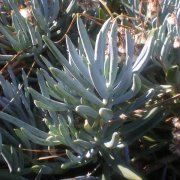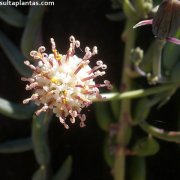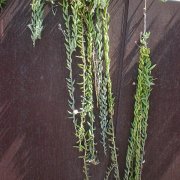Care of the succulent plant Senecio serpens or Blue chalksticks |
|
The genus Senecio, family Asteraceae, comprises 1,6000 species of herbaceous succulent plants and shrubs distributed over all continents. Some species are: Senecio serpens, Senecio rowleyanus, Senecio petasitis, Senecio mikanioides, Senecio mandraliscae, Senecio kleinia, Senecio cruentus, Senecio barbertonicus, Senecio angulatus, Senecio stapeliiformis, Senecio pseudolongifolius, Senecio elegans, Senecio bicolor, Senecio macroglossus, Senecio jacobsenii, Senecio scaposus, Senecio compactus. Common name: Blue chalksticks. This species is native to South Africa. They are succulent plants with a creeping habit that can produce roots in the stems and reach 30 cm (11.8") in height. They have attractive fleshy, cylindrical bluish-green, pointed leaves. The flowers are small, cream-colored, and scented. They bloom in summer and early fall. Blue chalksticks is used to cover slopes and dry areas of the garden, on walls and in hanging pots for patios and terraces. Senecio serpens can grow in full sun or light shade exposure. In very hot summer climates they prefer semi-shade. It resists frost down to -3 ºC (26.6 ºF) but it's better that the temperature is not lower than 6 ºC (42.8 ºF). The soil can be a commercial cactus substrate or a mixture of 50% garden soil and 50% coarse siliceous sand. Water moderately in spring and summer at the rate of one watering every 2 weeks. In winter water once every month and a half. Senecio serpens does not need fertilizers. Prune lightly after flowering to control growth. Blue chalksticks does not present major pest and disease problems if it's not overwatered. Senecio serpens is propagated from stem cuttings in spring or summer. |
Images of the succulent plant Senecio serpens or Blue chalksticks |
Find plants
Senecio serpens or Blue chalksticks | Care and Growing
© 2026 FavThemes



